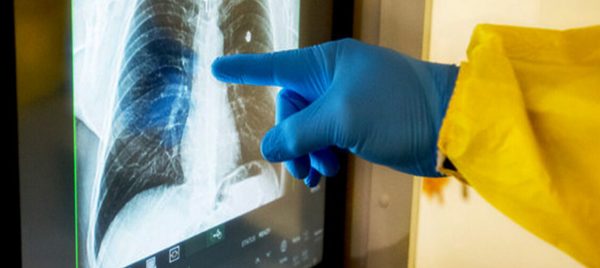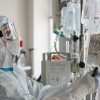 Due to covid, asymptomatic tuberculosis can become active, the Ministry of Health said. Patients after suffering from coronavirus are at increased risk of developing tuberculosis, according to the recommendation for the prevention and treatment of COVID-19. Phthisiologist Anna Belozerova told Pravmir.ru whether Russia is threatened by an epidemic of tuberculosis.
Due to covid, asymptomatic tuberculosis can become active, the Ministry of Health said. Patients after suffering from coronavirus are at increased risk of developing tuberculosis, according to the recommendation for the prevention and treatment of COVID-19. Phthisiologist Anna Belozerova told Pravmir.ru whether Russia is threatened by an epidemic of tuberculosis.
Why will there be more patients with tuberculosis?
“Can the coronavirus pandemic provoke an increase in the incidence of tuberculosis in Russia?”
“It is still impossible to establish a direct causal relationship between covid and tuberculosis. Too little time has passed and the coronavirus infection is not yet well understood.
But, despite the fact that linear logic does not work here, an increase in the incidence is possible for several reasons.
First, CT scan is done to many people with covid, which allows detecting small forms of tuberculosis. That is, the number of diagnosed cases of tuberculosis may increase due to the fact that now more people than before are referred for computed tomography.
Second, patients with severe covid are treated with steroid hormones. These are drugs that suppress the immune system. As a result of the use of such drugs, immunosuppression occurs, which can become a risk factor for the development of tuberculosis.
Coronavirus has significantly affected the provision of health care in other areas. For a long time, professional examinations have not been carried out. This can also affect the increase in incidence in the future.
In addition, during the pandemic, socially vulnerable groups of the population who are most affected by tuberculosis fell out of medical control: patients with HIV, those who take immunosuppressive drugs, and patients with diabetes.”
“Can coronavirus provoke the transition of tuberculosis from a latent form to an active one?”
“Any serious infectious or non-infectious disease is stress for the body, which is accompanied by a massive release of cortisol, which can provoke an exacerbation of a person’s latent tuberculosis infection. It doesn’t matter if it is a disease, a difficult personal experience or some other reason.”
“Can an epidemic of tuberculosis occur in Russia in the near future?”
“An epidemic of tuberculosis is not expected. There were 41.2 cases of tuberculosis per 100 thousand population in Russia in 2019, according to official figures. An epidemic is an indicator of 100 cases per 100 thousand people. If you completely stop treating people with infectious tuberculosis, then in 10 years an epidemic may occur, but so far there are no such prerequisites.
It can be assumed that in a year and a half there will be an increase in the incidence of tuberculosis due to the fact that many anti-tuberculosis institutions were closed due to covid, the work of dispensaries was limited, and professional examinations were canceled. This is the so-called “dark side” of the fight against the covid pandemic. Many aspects of medical care and public health have been relegated to the background.”
“What is the difficulty in fighting tuberculosis?”
“As a medical problem, tuberculosis is not a significant problem. With early detection and proper treatment, this is a curable disease.
But this is a huge medical and social problem. Besides, tuberculosis is linked to drug addiction, HIV infection and alcohol dependence. Sometimes people with these diagnoses do not want to be treated.
You can put as many tomographs as you like and open a huge number of laboratories, but this will not solve the problem. The fact is that tuberculosis can be defeated only by working with the so-called vulnerable categories. And as long as we have a high incidence of HIV infection and its prevalence, we will be among the countries with the least favorable situation in terms of the incidence of tuberculosis.”
How to identify latent tuberculosis
“What is latent tuberculosis?”
“At least 50% of the population is infected with tuberculosis bacteria in Russia. They are carriers of latent tuberculosis infection. When these people had contact with a patient with tuberculosis, the immunity coped with this, but nevertheless, the so-called tuberculosis bacillus or Koch’s bacillus remained in the body. It slumbers in the form of the so-called L-forms – that is, it is neither alive nor dead, with the ability to reproduce. When there is some kind of stress in the body, it wakes up and begins to multiply intensively, thereby causing active tuberculosis.
In the first two years after the initial infection, the risk of this latent infection turning into an overt disease is greatest, which is why doctors insist on regular diagnostics in children.”
“How is latent tuberculosis detected?”
“It is detected using the Mantoux test, diaskin test and other studies.”
“Can people with latent tuberculosis infect others?”
“This is a typical delusion. Latent TB infection is not a disease. In this case, a person is a carrier, but he is healthy and cannot be contagious.
But in order to prevent this infection from becoming an overt disease, we prescribe preventive treatment, which is aimed at destroying the dormant bacteria.”
“The Mantoux test is usually done for children, and fluorography test is for adults only once a year. Why is it so?”
“The reason is that it is rather useless to do immunological tests for adults in a country with a high prevalence of latent infection. Good screening should not be total, but purposeful.
It is important to identify the infection and carry out prophylaxis for children and vulnerable groups.
Vulnerable groups are, first of all, patients with HIV infection, they need to have immunological tests and fluorography or x-rays done every year. Likewise, these are patients who take drugs that cause a decrease in immunity, patients with diabetes mellitus, and other risk groups, including both social and medical.”
How To Avoid Getting Sick with Tuberculosis?
“Is it necessary to treat latent tuberculosis?”
“There are certain indications for the treatment of latent tuberculosis. It should be treated in children, especially those of preschool age, HIV patients, organ transplant patients taking immunosuppressive drugs, people with diabetes mellitus, as well as healthcare workers (this is one of the most significant risk groups, since there is a large morbidity).
Having identified a latent tuberculosis infection in a patient, the phthisiatrician must first of all assess which is higher the benefits or risks of prevention. If the risk of side effects of anti-TB drugs is less than the benefits of this prophylaxis, naturally, the doctor should prescribe treatment, since it is always necessary to act in the best interest of the patient.”
“What diagnostics should be done for an ordinary adult without serious pathologies in order to reduce the risk of developing tuberculosis?”
“It is enough to do a fluorography test once a year.”
“Can you confuse tuberculosis and coronavirus on fluorography or CT?”
“No way. It is impossible to confuse them.”
“How does BCG vaccine work?”
“It has been proven that BCG vaccine protects against the development of severe forms of tuberculosis. It reduces the risk of infection by 20%.”


















